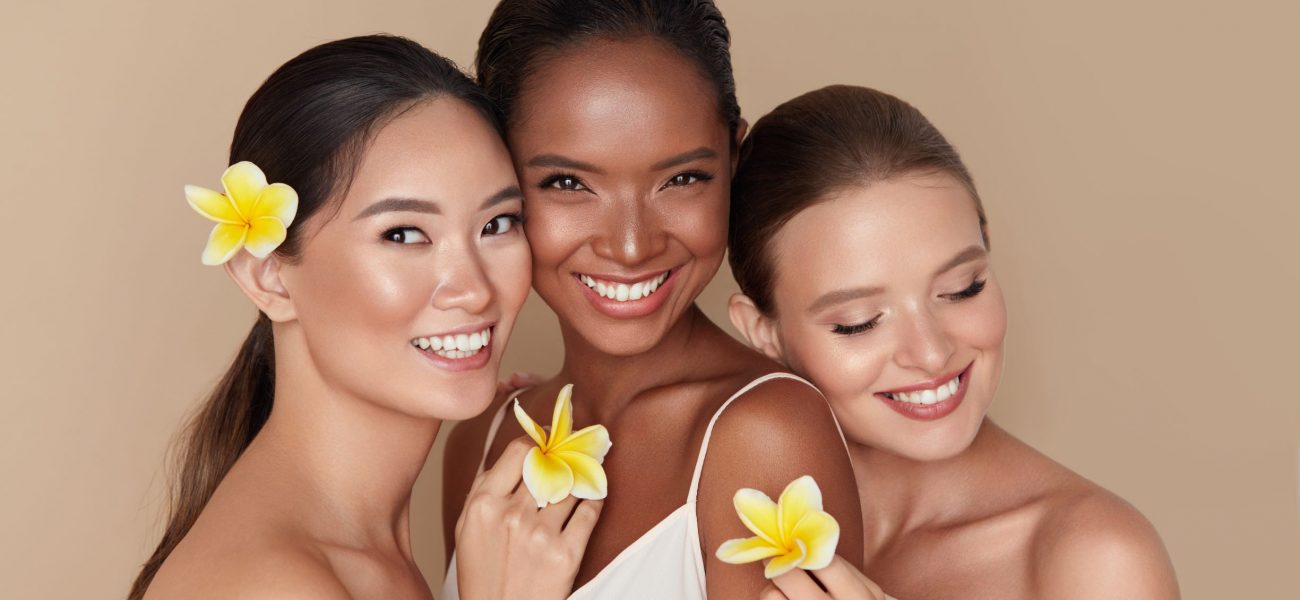If you’re wondering how to get glowing, healthy skin, then this is the guide for you, packed with health and beauty tips for flawless skin. Get ready as we outline key ways to boost the vibrancy of your visage, through a mix of hydration, nutrition, cleansing, exfoliation, and shimmer. But first up, the basics. Why is skin so important? Well, it’s the largest organ, helping to protect us from the elements and toxins. It’s easy to take for granted, resulting in a dull, tired complexion. However, there are plenty of ways to boost the vitality of your face, giving you the glow-up you’ve always desired.
Get your beauty sleep
Sleep is incredibly important for regenerating the health of your skin. So, if you’re still occasionally sleeping in your makeup and think it’s OK, let industry expert Caroline Hirons put you straight when it comes to skincare myths: “Stop saying that it is OK to sleep in your make-up. It is not. The average woman wears a mix of the following: SPF, primer, foundation, powder, concealer, blusher, bronzer, eyeshadow, eyeliner, mascara, brow pencil, lip liner, lipstick and lip gloss. That is a lot of product on your face. SPF, in particular, is designed to stick to your face; that’s its job. Add to that all the dirt and pollution from being outside and you have the perfect storm brewing for signs of skin distress: spots, dehydration, dullness – a whole plethora of issues. Wash your face at night, at the very least with lukewarm water.”
Why not take a leaf out of Lisa Snowdon‘s book, and treat yourself to a nightly skin care routine: “As your skin regenerates while we sleep, it’s good to feed it with all the right ingredients before your head hits the pillow. I love to slather on a deliciously rich cream.”
If you regularly have trouble sleeping, we’ve got you covered with our guide on how to fake sleep – these free beauty tips may not improve your mood, but they’ll definitely give you a healthy, natural glow!
Stay hydrated and drink more water
The number one route to glowing, beautiful skin is to stay hydrated, which can be a challenge during some months of the year. So, if you’re wondering ‘how can I keep my skin hydrated in summer?’, keep your reusable water bottle to hand, especially when exercising, and try to drink 1.5-2 litres or 6-8 glasses of water a day.
Amazingly, there is even gin that can boost your dewy glow. Aptly named CollaGin, this is the first gin distilled with pure collagen, as well as anti-aging botanicals such as star anise, which is packed with antioxidants; pink grapefruit, which slows cell ageing; and orris, which helps skin to retain moisture. While its collagen content of 100mg per 500ml bottle doesn’t compare to other products (the collagen drink Skinade, for example, has up to 7,000mg per 150ml), if you’re going to sip a G and T, why not make it this gin which may help you to look younger in the process?
Eat antioxidant-rich foods to nourish your skin
As much as we all love the familiar beige hue of a cheeseboard, having a rainbow of colours on your plate is better for your gut and your skin. “Avoiding oxidation damage is important to keep it elastic,” explains Henrietta Norton from Wild Nutrition. “Oxidation results in ‘cross-linking’ of proteins that toughens up the skin, making it leathery and leaving it prone to wrinkles. But luckily, antioxidants can reduce this. These antioxidants are found in abundance in the skin and colour of vegetables and fruit, so building in a rainbow of colour into each meal is the simplest and most nourishing way to support oxidation. Selenium is a powerful antioxidant trace mineral that’s responsible for maintaining elasticity and firmness.”
An easy, skin-friendly snack that you can keep in your handbag is Brazil nuts. “These are rich in selenium,” says Henrietta. “Eating just three or four per day provides adequate selenium intake for most people. Other rich sources of vitamin E include wheat germ oil, sunflower seeds, almonds, spinach, peaches, prunes, tomatoes, cabbage and asparagus.”
To achieve a glowy complexion, eating enough fatty acids is essential. “Fatty acids, such as those found in mackerel, nourish the top layer of the skin and keep water ‘locked in’,” explains Henrietta. “However, simply increasing your intake of oily fish or flaxseed oil may not be enough – a deficiency in magnesium can affect how well we use these oils. Therefore, eating a diet rich in green leafy vegetables or supplementing with a natural form of magnesium can really help. Green leafy vegetables, such as chard or cavolo nero, are also rich in vitamin C and magnesium; two important nutrients for forming collagen, metabolising omega-3 and producing hyaluronic acid – the skin’s ‘trampoline’, which gives it a hydrated, plump look and feel.”
Try natural skincare ingredients
There are a plethora of natural ingredients to look out for when buying skin care products. If you’re looking for a cleanser, Dr Cetto of ZO Skin Health suggests using oat-based amino acids: “these cleanse the face without drying it and help to revive our skin barrier’s function.” And sometimes, when it comes to cleansers, simplicity is better. “Castor oil is extracted from castor beans and is excellent for cleansing and peeling because it’s not quickly absorbed,” says dermatologist Emma Coleman. “It attracts and draws the dirt and oil out so it can then be removed with a tepid cotton face cloth or muslin.”
Another essential is a toner that you can use after cleansing. “Waters such as rose water, orange blossom and lavender tighten pores after cleansing to protect the skin from contaminants,” says Emma. “These extracts are also kinder, so they won’t leave your face red and angry. Witch hazel has been used as an astringent for centuries and helps to control excess sebum production, making it a good choice in toners for acne-prone skin, as well as anti-ageing products.”
Removing dead cells doesn’t just make our skin feel soft, it gives it a brighter appearance for radiant skin. “One of the most popular body exfoliator ingredients around now is coffee,” says Rachel Huskinson, beauty therapist and director of SKIN Lounge. “Ground coffee can treat cellulite as it contains caffeine and targets redness, acting as a natural anti-inflammatory when used on your face and body. Himalayan pink salt is another great ingredient as it targets rough and dry skin.”
Key natural ingredients
“Ingredients such as honey, jojoba oil, avocado oil and olive oil are great natural ingredients to look out for when you’re buying body oils, moisturisers and creams,” says Rachel. “Olive oil contains antioxidants that fight free-radical damage and also contains squalene, which hydrates. Vitamin E is another common ingredient found in oils, creams and moisturisers which repairs the skin, as well as reviving it after UV damage and keeping moisture locked in. Another key ingredient to look for in creams is vitamin A (retinol). As well as reducing fine lines and wrinkles by increasing collagen, it’s also used to stimulate the production of new blood vessels, increasing the cell turnover and improving uneven skin tones.”
Exfoliate to get rid of dead skin cells
Thankfully, the years of thinking that exfoliators would strip our skin of moisture are far behind us. These days, they’re best-known for helping us achieve a luminous glow. “An exfoliator should contain ingredients which remove excess oil, pollutants and dead cells,” says Dr Cetto of ZO Skin Health. “Jojoba esters, from the [jojoba] plant, help remove dead cells and unclog pores. Beta and alpha-hydroxy acids will chemically exfoliate and mechanically remove those cells. Other ingredients to keep on your radar are antioxidants such as vitamin C (serums rich in this vitamin are great), which protect and neutralise free radicals.”
Take inspiration from Lisa Snowdon, and exfoliate your body in the shower or before a bath: “Every morning before my shower I dry body brush to stimulate lymphatic drainage, which is great for banishing cellulite and boosting circulation. If you’ve not tried it before, it’s easy – you simply use a natural bristle brush and work in gentle circular upward motions on your body, making sure your strokes are towards your heart. Once a week I try to have a spa evening, lighting a candle and drawing a long hot bath. While soaking, I cleanse and then exfoliate my face using Aurelia Refine and Polish Miracle Balm Scrub, which is really gentle and contains probiotics to help reveal brighter, healthier looking skin.”
Cleanse your skin
It’s not just important to cleanse your face if you wear make-up; throughout the day, our face is exposed to pollutants, so it’s essential that we commit to a regular cleansing skin care regime.
According to Lisa Snowdon, “Once in the shower I use Sarah Chapman’s lovely Ultimate Cleanse which dissolves any impurities and removes make up perfectly. Afterwards, I love to use Balance Me’s Super Toning Oil all over my body and I add SkinCeuticals C E Ferulic Acid to my face, which brightens my complexion and helps with pigmentation which has come from sun damage over the years.”
Andrea McLean is also rigorous with her routine: read our article on how she keeps her skin healthy.
Moisturise and use face masks
Sometimes changes in the environment can make our faces feel dry and dehydrated, so choose a moisturiser that won’t block your pores. All skin types need moisturiser, even if you have oily skin, and don’t forget to moisturise your neck, too. “Avoid anything not lipid-based, as this can clog your pores,” says Dr Cetto. “A cream high in proteins can also disrupt our natural barrier, so look out for ingredients such as retinol, which stimulates renewal and collagen production, as well as vitamin E, which provides antioxidant properties.” Moisturisers that are packed full of vitamins are must-haves. “Flavonoids and vitamins A, B, C and E will nourish and protect dry types,” says dermatologist Emma Coleman. “Niacinamide is proven to be particularly effective in rosacea reduction, and beta-carotene helps to maintain overall skin health.”
According to Lisa Snowdon, “A facemask is a necessity and depending on what my face needs, I either use Malin+Goetz Facial Detox which is amazing for any breakouts and can be used on blemishes such as pimples to dry them out, or Sisley’s Black Rose Cream Mask, which is super-hydrating and a gorgeous, luxurious treatment I leave on overnight. These simple yet effective steps really do help my skin – keeping the pores super clean and the texture and condition hydrated.”
Supermodel Miranda Kerr’s skincare routine involves moisturiser with fatty acids for the ultimate hydration: check out her beauty secrets.
Don’t forget to use sunscreen
According to Dr Walayat Hussain from Bupa Health, “A recent study showed that only 17 percent of Brits said they wore sunscreen every day. SPF must be applied every day, especially on sunny days. It’s important to ensure your foundation or moisturiser has SPF so your skin is protected on a daily basis. Introducing sun protection into your routine is the best way to prevent premature ageing and the more serious conditions associated with over-exposure, such as skin cancer.”
Suncream is an important part of Lisa Snowdon’s routine, too: “Last but not least is sun cream – and yes, I use this even in the winter! A SPF of 30 is so important, as the sun’s rays can still cause damage and ageing. Cosmedix Reflect SPF 30 is brilliant.”
If you’ve had your fair share of the sun, and find that wrinkles are forming a little sooner than you’d like, check out our natural beauty tips to use as alternatives to Botox.
Add some make-up
Use shimmer to highlight and brighten your face
Wondering how to get a glowy make-up look? You’ve come to the right place! According to professional makeup artist, Chrys Chapman, “One of my favourite makeup hybrid products to address slow production of collagen and dull skin is Bobbi Brown Extra Illuminating Moisture Balm, as it packs a rich, textured hydrating punch and soft pearlescent glow that illuminates the face.
“Lots of skin experts will tell you that shimmer and glitter are simply off limits, especially for a mature woman, but here’s a secret – the key is placement. Take shimmery products such as powder highlighters too high up the lid, and you are almost guaranteed to place it on an area where the texture of the skin is not what you want to highlight.”
Try these make-up buys to look your best
“For an even complexion and beautifully hydrated skin, use a tinted moisturiser,” says Lucy Baker, professional make-up artist and founder of Make Up Mastery. “Apply your moisturiser as usual before a tinted product for a luminous-looking complexion. Apply with your fingers and massage in really well so that the face looks radiant. Light facial massage also livens up the complexion and stimulates lymphatic drainage, puffiness and fluid retention. Try Caudalie Teint Divin Mineral Tinted Moisturiser.”
For long, lustrous lashes, Lisa Snowdon’s favourite mascaras should do the trick: “L’Oreal Volume Million Lashes So Couture is great for gorgeous, thick, long lashes. I find that Benefit They’re Real mascara gives a brilliant false lash effect, and Dior Diorshow is really worth the expense.”
Defined brows are must-haves in order to frame the face, but sometimes eyebrow products can be a little pricey. So, if you’re looking for an alternative to something like Benefit Gimme Brow, we’ve got you covered with a dupe best buy that’s sure to impress you!



















